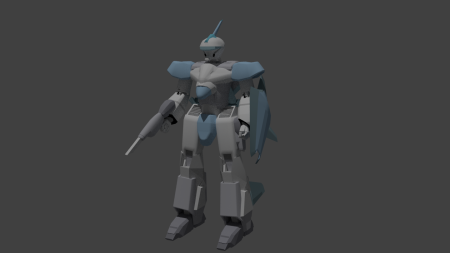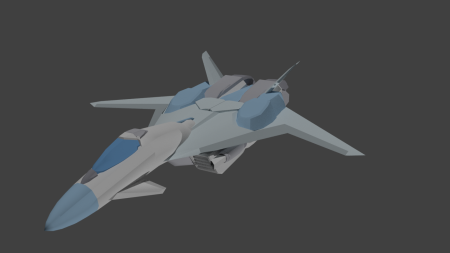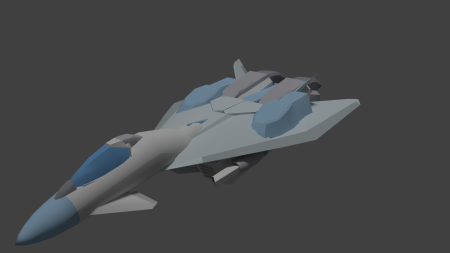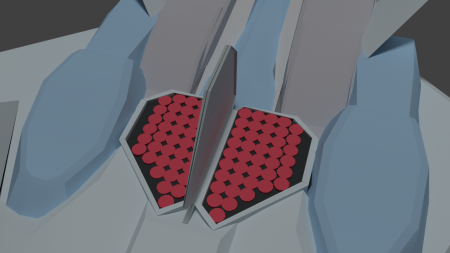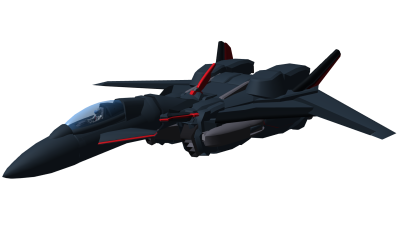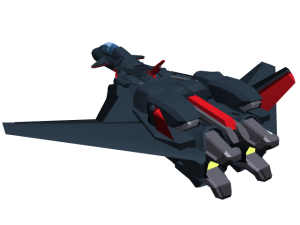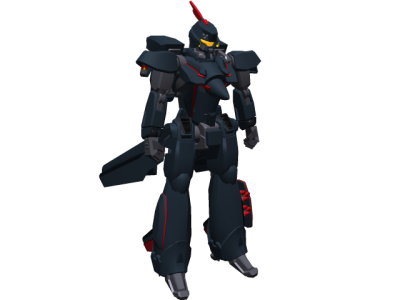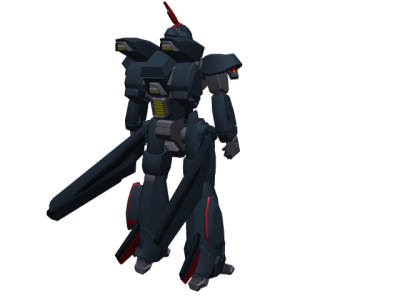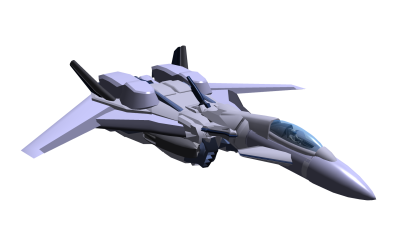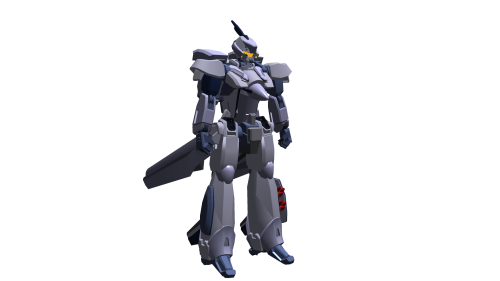Table of Contents
VF-41 Sparrowhawk
The VF-41 Sparrowhawk is an advanced Variable Frame designed by Osman Heavy Industries in cooperation with the New Dusk Conclave and the Exodus Fleet during the midst of the Kuvexian War. Introduced shortly after the outset of the Kuvexian Invasion of YE 41.
About the Sparrowhawk
The Sparrowhawk is a well-rounded Variable Frame, capable of effective combat against strike craft and other frames, but retains the capability to perform strafing runs and to do some damage to small starships through the use of its plasma repeaters. It has high maneuverability in both modes and a high-speed mode for extreme speed in-atmosphere.
Key Features
The Sparrowhawk features a varied missile loadout capable of dealing with both Power Armor and frames, as well as a fixed armament capable of dealing with frames and small ships. It is highly maneuverable and adaptable, and skilled pilots can find ways to take advantage of the transformation systems to pull off creative maneuvers. Additionally, it features a new intermediary mode, between Fighter and Frame modes, which can be used for VTOL and high-speed hovering.
History
The Sparrowhawk was developed initially as a variable interceptor under the project name of “Variable Frame, type 41” and was designed primarily to fight off other strike craft. However, the evolving reality of the Kuvexian War prompted the primary designers to consider a heavier gun armament, making it capable of strafing runs against small ships and of fighting off other frames. Its shared development, between the New Dusk Conclave, the Exodus Fleet, and Osman Heavy Industries itself led to both issues and advantages in development. Each group brought different ideas to the table, which caused arguments over what design characteristics to pursue, but also their own advantages and unique technological advantages. This, in the end, led to a final product that was well rounded and had the best technology that each had to offer. Incidentally, much of the design basis for the Sparrowhawk came from the preceding U-1.
It was also the first product in which OHI began to shift its nomenclature to better suit Yamatai's language, as in Yamatigo, the term “mecha” previously used by OHI caused confusion as it was often used simply to refer to anything mechanical or any machine.
In YE 43, a specialized variant was requested by the Conclave, leading to the VF-41N variant of the craft. Two years later, in YE 45, the Sparrowhawk was adopted the the Star Army of Yamatai as the VF-41-IIY, or the Haitaka, following the craft's entry in the Next Gen Fighter Program.
Appearance
The Sparrowhawk is, in fighter form, a fairly standard looking fighter with forward-swept wings, which help give it increased agility. It has canards on its front, and no horizontal tailplanes, instead opting for canted vertical tailplanes. It has a plasma repeater mounted to each side of the fuselage, and missile bays on both the flanks, near the engines, and the dorsal section of the fuselage.
In frame form, the plasma repeaters can be held like rifles, its dorsal missile pods are mounted on the back, and the wings sit by the legs. The engines and intakes of the fighter form comprise the legs in frame form.
Statistical Information
- Type: Variable Frame
- Class: OH-V1-1a
- Production: Mass
- Price: 100,000 KS
- Crew: 1
- Maximum Capacity: 2
- Mass: 30 tons
Dimensions
Fighter mode
- Width: 13m wings unfolded, 7m wings folded back
- Length: 15m
- Height: 4m gear down
Intermediary mode
- Width: 13m wings unfolded, 7m wings folded back
- Length: 10m
- Height: 7.5m
Frame mode
- Width: 7.6m
- Length: 6m
- Height: 12.6m
Speeds
- Range: 20 days, limited by life support
- Lifespan: 20 years
Damage Capacity
See Damage Rating (Version 3) for an explanation of the damage system.
- Body: Tier 8, medium mecha, medium armor
- Shields: Tier 8, medium mecha
Interior
The cockpit of the Sparrowhawk is spacious and comfortable. The pilot sits in a suspended shock-absorbent chair, with two armrests, each of which has a joystick and button pad at the end. In front of them is the main console, with three screens, one fixed main display, plus two multifunctional displays, and a row of buttons. The pilot's feet rest on two pedals.
When piloting, either of the two joysticks can be set to control the throttle while the other is used to control pitch and roll. The pedals are used to control yaw normally.
In an emergency, the cockpit block can be ejected while in any of the modes.
Weapons Systems
The Sparrowhawk is armed primarily for anti-small-craft duties, with its two plasma repeaters and missile payload. Each of the weapons are located in such a way as to be usable in all modes.
- 2x dorsal missile bays, loaded with 40 Mini Missiles each12): Tier 7, light anti-mecha
- 3x Macro Laser on the head14): Tier 3, heavy anti-personnel
- 1x Hyper shift in energy mode, in the antenna on the head: Tier 6, heavy anti-armor
Onboard Systems Descriptions
Armor
The Armor systems of the Sparrowhawk pull from the technological bases of each of the groups that contributed to it. The armor is a composite of Osmanium, Durandium Alloy, and graphene-doped plastics. This combination makes the armor middleweight, highly protective, and benefit from the qualities of Osmanium.
Power Systems
The Sparrowhawk is powered by a single Class 1 Hyperspace Fuel Tap that feeds two miniature cold fusion reactors, one in each leg.
Life Support
Like many other designs from groups originating in the OSO, the Sparrowhawk uses a Liquid Ally based life support system based on that found in the production model U-1. This life support system regulates air quality and content, temperature, and other life critical variables, and can do so for one month before needing to be checked.
Shields
The Sparrowhawk uses conformal electromagnetic and gravitic shielding. This combination is effective at protecting against most threats.
Propulsion
The Sparrowhawk's propulsion is provided by two class three plasma thrusters that are fed by the reactors in its legs/fuselage. Additionally, it has a backpack with auxiliary thrusters on it fed directly from the fuel tap, which rests between the two 'legs' when in fighter mode.
Maneuvering Thrusters
In addition to the main thrust units, the Sparrowhawk features maneuvering thrusters located on its back, to help it turn in Zero Gee more easily.
Sensors
The Sparrowhawk has several different optical arrays located inside its head, several back-up cameras (located on the torso, shoulders, and legs), and a OH-V1-E4400 Unified Small Craft Sensor Package array located in its chest, or the nose when in fighter mode.
Internal Skeleton
The Sparrowhawk uses the same style of internal skeleton design as the Oxen Multipurpose Mecha, which has integrated high-powered servomotors and pneumatic systems and an inner skeleton that is wrapped in strands of high-powered artificial muscles interlaced with filaments of Liquid Ally. This whole assemblage is covered in an outer skin of Liquid Ally that protects the innermost workings of the frame, enacts basic and moderate repairs in the field, and perform basic maintenance activities autonomously - thereby decreasing maintenance times and costs.
Some modifications to the skeletal structure have been made for transformation, as well as to allow for power and plasma to be supplied to connected devices via ports in the hands and on the hips15), but the principles behind the design remain the same.
Transformation Mechanism
When the sparrowhawk is transforming from fighter mode to either its intermediary mode or its frame mode, the first thing that happens is the arms, which are located in cowlings on either side of the missile bays on the dorsal surface of the fighter swing outwards and then expand, the forward portion of the cowling becoming the shoulder, and the bottom portion becoming part of the lower arms.
The second thing that happens is the engines, which are actually the legs, dropping downwards on a specialized hip joint, to allow them clearance to swing forwards. If transitioning to the intermediary mode, this is where the transformation ends.
If transforming into the frame mode however, first the wings begin to detach themselves from the fuselage, except for their holding point which will later sit behind the waist of the frame mode. The forward portion of the fuselage and the nose and cockpit block then begin to fold into themselves. The majority of the cockpit area, including the cockpit, folds so that the glass portion is facing towards the rear of the frame, and forms the spine while the nose of the aircraft sticks out of the front of the chest. This is then covered by the maneuvering block, which becomes the backpack. Other portions of the fuselage then rearrange to better armor and protect this spine, which is the core of the torso, and the head is lifted out of its cavity as the torso finishes its transition.
During normal operation, all of the aforementioned parts of the transformation will actually be happening concurrently, not in sequence, so as to make the process speedier. Unlike the far more complicated transformation of the U-1, this transformation can take place in 4 seconds.
Modes
The VF-41 Sparrowhawk has three modes of operation, which are transitioned between by transforming parts of the craft.
- Fighter Mode: Fighter mode is used for similar tasks as a normal non-transforming fighter, in the case of the Sparrowhawk, these tasks are interception of enemy strike craft or if needed ground support, though the Sparrowhawk is first and foremost an interceptor.
- Intermediary mode: This mode provides the pilot with a middle ground between the fighter and frame modes. This mode has more discreet maneuverability than the fighter mode but less than the frame mode, and more speed than the frame mode but less than the fighter mode. It is also useful for attaining high mobility when operating near or on the ground, as the ground effect allows it to travel quickly while maintaining a stable firing platform for combat.
- Frame mode: This mode is used for ground and urban combat, making the Sparrowhawk useful for operations where more firepower is required on the ground and conventional vehicles are not available. This mode has the most discrete maneuverability, making it useful for quick changes during a dogfight, or when taking on smaller opponents who might be able to otherwise outmaneuver the fighter or intermediary modes.
Standard Equipment
The Sparrowhawk comes with several pieces of standard equipment, kept behind the pilot's seat in a storage block, and are carried with the seat upon ejection. These include:
- 1 first aid kit
- 7 days worth of emergency rations
- A repair kit with tools
- A weapon rack with room for one pistol and one small rifle or carbine and ammunition
- An emergency beacon
VF-41N Variant
In YE 43 after two years of use, the New Dusk Conclave approached OHI with a set of requirements for a variant designed to meet NDC needs. While the most striking changes were to the exterior architecture of the design, much of the interior is similar though certain technologies such as the NH-M-M4 "ARCO" and BW-E-2 Anima System are incorporated. The Generic graphene-doped plastic is also changed to Madite-C and a Sensory Smart Coating is added for stealth.
Additionally, the variant added extra thrusters to the arm-cowlings, which were converted into booster pods when in frame mode, improving STL speeds slightly.
VF-41-IIY "Haitaka"
When the Next Gen Fighter Program reached out to OHI in YE 44 seeking a proposal for the program, the firm was quick to respond with a version of the now well-tested craft altered to suit the needs of the NFGP and the Star Army of Yamatai, initially naming the project “北雀鷹 ”, or “Northern Sparrowhawk”. The Yamataian name was considered cumbersome by some engineers and test pilots however, who took to calling it the “Haitaka” instead. The name stuck, and was used moving forward. The original kanji are still emblazoned on every unit's head, however. The first change made was to re-engineer the craft to have extremely high maintenance commonality with other Star Army small craft, and almost all non-core components were replaced with standard Star Army systems. In addition, it slightly modifies the leg units, allowing the mounting of an Integrated CFS Array for shielding, FTL travel, and other functions.
The core computer system was mostly replaced with a Compact Integrated Electronics System (CIES) with custom tuning and SPINE compatiblity, and it was fitted with a Sorakagami Aerospace Operations Suite and Type 44 Electronic Warfare Suite. Due to Osman Heavy Industries' close cooperation with Yugumo Fleetworks, the new OH-V1-E4400 Unified Small Craft Sensor Package was able to be integrated with these systems with no issues. The standard gravitic control system was replaced with an Azure I Series Anti-Gravity System for better maintenance commonality with other newer Yamataian craft.
The standard adaptive paint of the unit has also been replaced with Omnihue for ease of livery changes and use as double-backup EM sensors, and as a stealth coating. This coating of Omnihue, as well as nodes of Xiulurium near emissive components, the Madite-C component of its hull, and the Sparrowhawk's already low emissions profile, makes it one of the most stealthy fighters in the Star Army's inventory.
If desired, the whole cockpit block can be swapped for a Type 32 Pilot Pod to make use of the Project Thought control system. Additionally, while not equipped by default, external “Sea Packs” can be mounted to the front and back 16) of the leg units and the rear of the cockpit block. These Sea Packs contain Umikagami Subsurface Operations Suite equipment tuned for use with the Haitaka's existing systems.
In terms of weapons, the Haitaka retains its original missile armament, albeit with updates from the OHI Missile Update Program, and replaces its Torrent plasma repeaters with modified "Taihō" Scalable Mass Driver autocannons17) firing 27x170mm HEAAP, tuned for fire at 600rpm and with a magazine of 800 rounds located in the “stock” of the gunpod. Each forearm has also been modified to stow a single Ke-M19-W4310 Plasma Blade in an easily accessible mounting on the back of the forearm, allowing the frames to engage in melee combat if the situation requires. The physical shield from the original Sparrowhawk was retained, and carries a reserve magazine for the autocannons which can be easily swapped in combat.
Additionally, the Haitaka replaces its standard maneuvering thrusters with a Plasma Projection System. They enhance the craft's maneuverability and can act as additional engines to boost the craft's speed even further, allowing it to fly as fast as some missiles. Alternatively, they can act as additional point defense or offensive weaponry, with up to three Tier Equivalent Weapon Groups18) worth of power available.
It also has four optional ordinance pylons, one on each wing root, and another halfway down the wing. The inner pylon has five hardpoints19), and the outer has three20). Standard procedure is to fly with only the inner pylons, or to fire the ordinance from the outer pylons and eject the pylons before transformation.
Hardpoint Information
Each hardpoint may hold one of the following:
Alternatively, each hardpoint may hold two of the following:
Two hardpoints, or the bottom hardpoint of each pylon can be used to hold one of the following:
Finally, the bottom hardpoint of each pylon can be used to hold one of the following:
- EM-O2 "Houmen" Communication Satellite in a launch tube
- Yomawari-Class NavComm Buoy in a launch tube
OOC Notes
Alex Hart created this article on 2019/09/29 20:38.
This design, in particular, its wing shape, takes inspiration from the YF-19 and VF-19, created by Shoji Kawamori
| Products & Items Database | |
|---|---|
| Product Categories | small craft |
| Product Name | VF-41 Sparrowhawk |
| Nomenclature | OH-V1 |
| Manufacturer | Osman Heavy Industries |
| Year Released | YE 41 |
| Price (KS) | 120 ,000.00 KS |
| Mass (kg) | 30,000 kg |
| Star Army Logistics | |
|---|---|
| Supply Classification | Class B - SMALL CRAFT |
| First Used | YE 45 |
